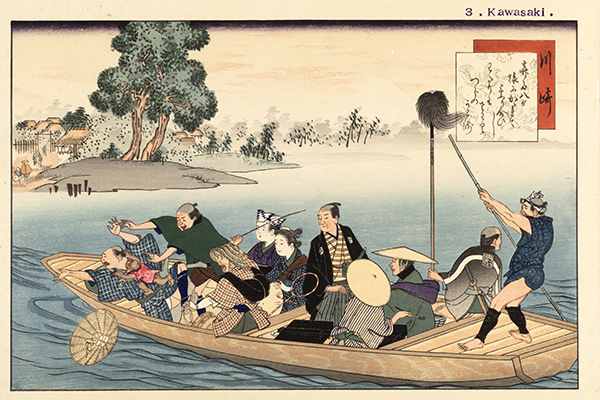
The new spring-semester exhibition at Hope College’s Kruizenga Art Museum invites visitors to journey back to the 19th century and travel a legendary Japanese thoroughfare.
Opening on Friday, Jan. 14, “Shank’s Mare Tokaido: Misadventures Along the Eastern Sea Road” will feature a suite of 60 Japanese woodblock prints depicting places and people along the famous Tokaido Road that once ran along the eastern coast of Japan, connecting the cities of Tokyo and Kyoto. The public is invited, and admission is free.
“I realize that the exhibition title, ‘Shank’s Mare Tokaido,’ sounds a bit odd,” said museum director and curator Charles Mason. “It comes from a famous 19th-century Japanese novel called Tōkaidōchū Hizakurige in Japanese, which is about two friends who travel from town to town along the Tokaido Road, experiencing many humorous adventures and mishaps as they go. The story in the novel is fictional, of course, but it includes vivid descriptions of the people and places travelers would have encountered on the Tokaido during the 19th-century, so it really is a valuable historical resource for understanding Japanese popular culture at that time.”
Established in the early 1600s, the historic route ran for more than 300 miles near Japan’s Pacific coast, with 53 post stations spread out along the way to provide food and shelter for travelers. For centuries, walking was the standard means of transportation on the Tokaido, although travelers with enough money could also rent horses and sedan chairs to carry them on certain portions of the road.
The Kruizenga Museum’s “Shank’s Mare Tokaido” exhibition includes 60 woodblock prints illustrating various episodes from the novel. The prints were created by artist Fujikawa Tamenobu and published in 1918.
“We don’t know much about the artist Fujikawa Tamenobu,” Mason explained. “These prints appear to be his only works, so we think another artist may have made up the name specifically for this suite of prints. Whoever the artist was, he was highly skilled and clearly knew a great deal about the history of the Tokaido. Many of the ‘Shank’s Mare Tokaido’ prints contain references to earlier pictorial representations of the road, especially the woodblock prints of Utagawa Hiroshige who produced close to a thousand images of the Tokaido during the middle decades of the 19th century.”
Six original woodblock prints by Hiroshige will also be on display in the exhibition so that visitors can see some of the connections to the earlier prints for themselves. Apart from woodblock prints, the exhibition will also include paintings, photographs, clothing, household wares and other items that shed additional light on the people, places and things portrayed in the Tokaido images.
“The prints are fantastic, but we want to make the world they portray as tangible as possible,” Mason said. “One of the reasons we are doing this exhibition at this time is because the COVID pandemic has made it difficult for many of us to travel in person, so we are trying to provide a kind of vicarious travel experience through the show. The prints are bright and cheerful and often humorous, so we hope the exhibition will be an antidote to the general wintertime and pandemic-related blues, at least for some people.”
“Shank’s Mare Tokaido: Misadventures Along the Eastern Sea Road” was organized by the Kruizenga Art Museum. As far as can be determined, this exhibition will be the first time the complete suite of “Shank’s Mare Tokaido” prints has ever been displayed in the state of Michigan. The exhibition will continue through Saturday, May 21.
The Kruizenga Art Museum is located at 271 Columbia Ave., between 10th and 13th streets. Public visiting hours are Tuesdays through Saturdays from 10 a.m. to 4 p.m. Admission to the museum is always free. Please check the museum’s website hope.edu/kam or social media for additional information about special programs and events related to “Shank’s Mare Tokaido.”
The Kruizenga Art Museum functions as an educational resource for Hope College and the greater West Michigan community. The museum features two public galleries as well as a study room and climate-controlled storage space for its 7,000-object permanent collection. It is named in honor of a leadership gift from the late Dr. Richard and Margaret Kruizenga of Holland, both of whom graduated from Hope in 1952.